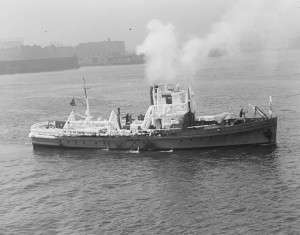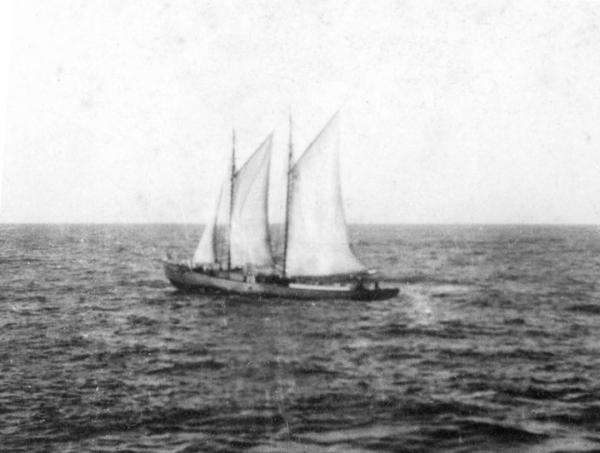For six years during the heart of Prohibition, New England Coast Guard patrols often saw the Gloucester-rigged schooner I’m Alone sailing off into the distance toward the open ocean. That was as close as they could get to the suspected rumrunner. She was fast and her captain cagey, and if not for an overdue New Hampshire library book they might never have unlocked her secrets at all.
Everyone had a pretty good idea what the I’m Alone was up to offshore. She wasn’t the only Canadian-registered boat that moved up and down the coast between Canada and Belize. They all provided a ready supply of alcohol for eastern U.S. cities parched by Prohibition.

$175,000 in liquor seized in Dorchester Bay from rumrunners. Photo courtesy Boston Public Library, Leslie Jones Collection.
The I’m Alone
The I’m Alone weighed in at 200 tons and 125 feet long, and she could carry 2,800 cases of liquor. Like other large schooners, she would load up with liquor in a foreign port, then stay out at sea out of the Coast Guard’s reach. Smaller rumrunners would pull alongside, take on a load of booze and blaze into port hoping to beat the Coast Guard and any other chase patrols. Once empty, the big supply boats would sail away to reload.
When the Coast Guard approached, the larger ships would simply move farther out to sea. International law prevented the Coast Guard from interfering. It was one of many of the cat-and-mouse games rumrunners played with law enforcement during Prohibition.
Everything changed, however, on the night of March 20, 1929, when the Coast Guard cutter Wolcott spotted the elusive I’m Alone in the waters off Louisiana.
The entire Coast Guard knew the I’m Alone, the most wanted boat afloat. In Halifax, countless entries in the customs logs showed her heading off to the French Island St. Pierre-et-Miquelon and from there to the Caribbean.
During the winter of 1928, I’m Alone shifted territory, heading to the West Indies, probably chasing southern tourist trade. As she sailed off the Louisiana coast, the cutter Wolcott stumbled across the I’m Alone.
Pursuit
With orders not to lose the boat, the Wolcott pursued the I’m Alone and hailed her. I’m Alone’s captain John T. Randell was a vigorous old veteran of the Boer War and World War I. He had become a rum runner by dint of lack of other work and the terrific pay.
When confronted by the Wolcott, he declined to let the Coast Guard aboard. He invited the Coast Guard’s commander on board for a pleasant meeting, as the customs of the times dictated. But he insisted he was 14 miles off shore, beyond Coast Guard jurisdiction, and he would not agree to be inspected nor stop his ship.
The Coast Guard was just as adamant that he was within 10 miles of land. The stalemate continued for two days. The I’m Alone continued steadily out to sea with the Wolcott trailing, waiting while help arrived.
After two days, another Coast Guard vessel, the Dexter, joined the Wolcott. Together the two renewed their threats. They would board the I’m Alone or they would sink it. Again Randell refused, and the shooting started.
In little time the Coast Guard shot the I’m Alone through the hull below the water line. It sank, bow-first, beneath the waves. The Coast Guard picked up all aboard, but one man – Leon Mainguy – perished.
As the Coast Guard returned to port, an international firestorm brewed that they could not have anticipated.
Controversy
Rather than receiving accolades for capturing the toughest rumrunner afloat, the Coast Guard was under fire. Canada declared the attack piracy on one of its vessels – no more, no less. The French and British condemned it, and Washington began scrambling to change the story.
Soon, the United States dropped charges against Randell and his men. Though acknowledged rumrunners, all evidence had sunk to the bottom of the sea. Canada pressed for damages – some $386,000 – and it seemed the U.S. government would soon have to pay.
The U.S. could turn the tide if it could prove that U.S. criminals rather than Canadians owned the I’m Alone. Based on the years they had spent chasing it around the waters of New England, the Coast Guard strongly believed that U.S. citizens owned the vessel, despite its Canadian registration.
The Coast Guard would get its break in the unexpected form of a library book. Late in 1928, the Coast Guard had almost apprehended a boat carrying liquor from the I’m Alone. They had chased the boat, the Cheri, but the crew torched the vessel and narrowly escaped. On board, however, a library book survived the fire. It came from a New Hampshire library and it led prosecutors to a gangster named Danny Hogan.
Inside Information
As the witnesses from the vessel began talking, they first fingered Boston gangster John Magnus. Magnus owned a garage in Boston’s Back Bay, but prosecutors charged he really used it as a front for a huge liquor smuggling business. The I’m Alone, they said, was the centerpiece of the operation.
The more they dug into the operation, the more they understood the I’m Alone’s invincibility off the New England coast. Magnus bribed four Coast Guardsmen, including a top Coast Guard official, for information about where and when the Coast Guard patrolled. He also had access to the codes the Coast Guard used when they communicated via radio. In at least one case, the Coast Guard even watched as the I’m Alone unloaded liquor.
Armed with his inside information, Magnus communicated with his own partners via a large radio broadcast facility on Cape Cod. That allowed the I’m Alone to always stay out of reach and its customers to make it safely to land before the Coast Guard could catch up.
Big Seven
In exchange for some leniency, Magnus explained the history of the I’m Alone. Built in 1923, he had bought the boat because of its speed – twin 100-horse-power diesels aided by sails powered the ship. The name, I’m Alone, referred to Magnus’ decision to operate independently rather than as part of an organized entity like the Big Seven Group, made up of future Mafioso.
But he corrected the misapprehension that he still owned I’m Alone. In 1928, library patron Danny Hogan, Marvin J. Clark and Frank Reitman — all Americans — approached Magnus. They, too, considered the I’m Alone the fastest boat afloat. As affiliates of the Big Seven, they wanted to buy it.
Putting together a fund of $20,000, the three asked Magnus to sell. After some dickering, the three paid $18,000 for the vessel and sent it south. Without the protection Magnus and his Coast Guard informant could provide, the I’m Alone was no longer bulletproof and its apprehension inevitable.
With the new information in hand, Canada backed off claims for damages for the boat’s owner. In the end, the United States paid $50,666 dollars in damages.
For more on the I’m Alone, visit here and here. This story was updated in 2022.




8 comments
There was a similar rum runner in this area called the Grey Goose. It’s captain knew how to slip through narrow island channels and elude capture for many years!
[…] Coast Guard needed a fleet of rum chasers to apprehend the rum runners — like the famous I'm Alone — that plied the waters from Canada to the […]
[…] explained. “This is exactly what happened in the Romanelli case, except that the Brooklyn killers used alcohol instead of a […]
[…] Bar Harbor will be red letter days in my life," he told the crowd. "The air is like champagne in a Prohibition state, and without the uncomfortable consequences that follow imbibing that […]
[…] speed out to the 12-mile limit, where they unloaded bootleg liquor from seagoing vessels. Then the rumrunners brought their contraband to a stone dock leading to Rettich’s crime castle. They stored the […]
[…] commanded a fleet of boats that brought bootleg liquor from Central America. They were guided by secret radio stations on Long Island and in New […]
[…] may also be interested in this story about Prohibition here. This story about speakeasies was updated in […]
[…] continued making Newburyport rum until Prohibition. When Prohibition ended, Alexander Caldwell’s descendants resumed production in 1934. But the New […]
Comments are closed.